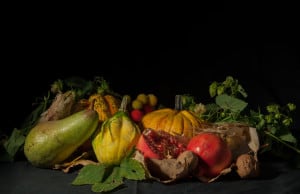Autumn Recipes for Healthy Lungs
 The Autumn recipes below are good for all of us at this time of year. They protect us from respiratory infections and intestinal problems and generally boost our immune system by nourishing this season’s Metal energy in the Five Element system of Chinese medicine.
The Autumn recipes below are good for all of us at this time of year. They protect us from respiratory infections and intestinal problems and generally boost our immune system by nourishing this season’s Metal energy in the Five Element system of Chinese medicine.
Metal relates to the function of our Lungs and Large Intestines, which, in the Chinese medicine system, includes regulating our immunity. At this is the time of year the health of these organs is most under threat – but we also have the greatest opportunity to heal them with our diet and lifestyle and with practices like MogaDao Yoga and Qigong.
If you are suffering any respiratory or intestinal weakness or imbalance or tend to melancholy or depression in this Autumn period (or at other times of the year), you might find these recipes particularly useful.*
To find out more about a healthy diet for Autumn and to learn about this season’s mind-body significance, read my other related blog posts:
– Eat Yourself Well this Autumn
– Autumn: the Precious Season of Reflection
Please note: the quantities in these Autumn recipes are just guidelines and are based on my own personal experience and preferences. Please feel free to be creative … and do get in touch me with any comments or suggestions.
– Stewed Pears with Warming Spices
This delicious recipe soothes, moistens and clears the Lungs, so it’s great if you have a stubborn cough or need to boost your immunity or hydrate dry skin. Pears are in abundance in the Autumn and have a particular affinity for the Lungs. They reduce inflammation, while easing dryness and clearing phlegm. The cooking of the pears helps prevent them from being too cooling (but those who suffer excessively from the cold should take care), while the addition of warming, pungent ‘Metal’ spices helps to activate the Lungs and disperse stagnation and mucus. Walnuts nourish the Lungs and lubricate the Intestines, so they make a tasty addition, especially in cases of coughs or constipation. The Kuzu, a flavanoid-rich white starch from Japan, thickens the liquid, but also has amazing health benefits for the Large Intestine, including relieving inflammation, discomfort and cramping.
Ingredients:
4 Pears, peeled, cored and quartered
1 Cinnamon stick
A little nutmeg
1 Vanilla pod, slice open lengthwise to release seeds
Fresh ginger, a few slices
A pinch of salt
Walnuts (optional)
1-2 tblspns Kuzu (optional)
apx 3 cups of Water
Method:
Place the pears, cinnamon, vanilla and ginger in a shallow pan. Add water to cover the base of the pan about 1cm deep. Cover and stew for about 20 minutes or until soft, but not breaking up. If using Walnuts, add for last 5 minutes or so of cooking.
When the pears are nearly ready, mix the Kuzu with a little water to dilute (be sure to get rid of any lumps) and add, stirring in well. Simmer for a couple of minutes until the liquid thickens slightly.
Eat the pears and their liquid warm for breakfast or as a snack. You can store the pears in the fridge.
– Sticky Rice and Adzuki bean Porridge
Rice is the grain specific to the Metal element, so it is very beneficial to the health of the Lungs and Large Intestines. Glutinous or sticky rice is slightly sweeter and higher in oils than normal rice strains. Barley can also be used (see Barley Water below for the particular benefits of this grain). Adzuki beans help to clear damp and contain fibres that are particularly good for the Large Intestine, helping to regularise its function (these legumes are always delicious when cooked long and then mashed, so are a frequent ingredient in Chinese deserts). Chestnuts are a fabulous Autumn addition that nourishes the Spleen (and in turn Metal’s organs) and provides natural sweetness. This recipe makes an excellent and nutritious morning porridge. A barley and adzuki version is one of the many delicious morning choices sold to busy commuters on their way to work from mobile carts on the streets of Taipei.
Ingredients:
500g Glutinous rice (or normal wholegrain rice or barley)
100g Adzuki beans, soaked
½-1 tspn salt
Water
Dried or cooked chestnuts – soak the dried ones. Chopped small (optional)
Your choice of sweetener (optional)
Method:
Mix the soaked and rinsed beans together with the glutinous rice and the chopped chestnuts (if using). Cook them all with plenty of water in a covered saucepan (preferably a pressure cooker) for apx 45 minutes.
Open the lid and add salt (do not add it before this if you want your beans to soften well …) and additional water if needed (it should be soup-like at this point). Use the back of a spoon to mash as many of the adzuki beans as possible, so the liquid thickens.
Keep cooking so the liquid continues to thicken and to evaporate a bit (or add more water as needed, so it does not get unpleasantly thick). When you have the consistency you like (I recommend a bit runny), it’s ready.
My children and I like this porridge with just the mild natural sweetness of the ingredients (especially if we have also used chestnuts), but add a little something to sweeten further if you must …
– Spiced Pumpkin and Cauliflower Soup
Warming soups are a welcome and healthy addition to your Autumn diet, especially if made with seasonal vegetables with affinities to the Earth and Metal elements, so that they nourish and tonify the Lungs and the Large Intestines. Pumpkin and cauliflower fit all these criteria, while the addition of pungent spices sharpens this soup’s Metal-element focus, helping to clear any stagnation.
Ingredients:
1 Pumpkin or Butternut Squash, peeled and chopped
1 Cauliflower, chopped
1 Onion, chopped
2 tsp Cumin seeds, freshly ground
2 tsp Coriander seeds, crushed
3-4 cloves Garlic, chopped
Ginger, fresh, a small chunk, finely chopped (optional)
Fresh parsley and/or coriander, roughly chopped
Vegetable stock
Olive oil
Salt
Method:
Use a little oil to fry the onions and garlic till soft and fragrant, then add cumin, coriander seeds and ginger (if using) and cook for another minute. Stir in the pumpkin and cauliflower, cover and cook over a low heat for 5 minutes.
Add the vegetable stock just to cover the vegetables and simmer for 20-30 minutes or until they are soft. Remove from the heat, add the parsley and/or coriander and allow to cool a little.
Blend the soup to very smooth and velvety (add more hot stock if needed). Season with salt and heat through. Serve hot, sprinkled with a little more parsley or coriander.
In my experience, soups taste even more delicious the day after they are made, so be sure to make plenty.
– Barley Water
Barley water is really great for the long-term health of the mucus membranes that line both our Lungs and Large Intestines (as well as our urinary tract). The mucilaginous compounds in the barley soothe, protect and moisturise, while also reducing excessive damp. Daily consumption of this liquid gradually reduces any ongoing inflammation in mucus membranes and minimises the possibility of future inflammation.
In our Lungs, it is a useful remedy for coughs and bronchitis. In our guts, it can be used to treat diarrhea and constipation, while promoting overall intestinal hygiene and creating an optimum environment for balancing intestinal flora (pro-biotics will be more effective). The health of our skin (sometimes know as our ‘3rd Lung’) is intimately related to that of our Metal organs, so this can also help relieve inflammatory skin problems. My recipe calls for Hulled Barley, which has only the outer-most hull removed, so is more nutritious than Pearl Barley.
Ingredients:
150ml Hulled Barley (= Barley Groats) or Pearl Barley, ¼ cup
1.5L water (or about 10 times the volume of water to barley)
Ginger, a little, grated (optional)
Lemon juice, to taste (optional)
Rinse the barley. Bring the barley and water (and ginger, if using) to the boil and simmer on a low heat, covered for 20-30 minutes. Turn off, leave at least 15 mins (best several hours).
Strain, gently squeeze out and conserve the liquid (the remaining barley can be eaten, if desired, but the mucilaginous compounds will have been removed). Add lemon juice, if using. Store in sealed containers in the fridge, but bring to room temperature to consume.
In case of inflammation, drink a small cup 2 or 3 times daily on an empty stomach. For long-term health, drink daily or at least 3 times weekly.
– Fermented vegetables (pickles)
Autumn is traditionally the season for pickling, for storing away nutrient-rich foods to be eaten during the paucity of Winter. There are numerous techniques for pickling and conserving, from the super-healthy to the very unhealthy.
Properly-made raw, unpasteurised fermented vegetables (sauerkraut) are among the most health-promoting foods available. Not only are they bursting with all the enzymes and vitamins of raw vegetables, but they contain loads of good bacteria for our guts and, being pre-digested by the fermentation process, do not have any of the draw-backs of raw food (excessively expansive and cooling, and hard on the digestion). Pickles have a particular affinity for our Metal organs and functions, boosting our immunity and restoring our intestinal flora to a healthy balance. Moreover, their sour flavour enhances the Autumnal process of drawing energy inwards and downwards. I recommend you eat a small amount each day.
There are many many websites giving very detailed and varied instructions on effective pickling techniques, so I do not intend to add to these. I encourage you to explore what is already out there and to experiment with your own pickling.
Here are some things to consider when pickling:
– I recommend making your owns pickles and sauerkrauts rather than using shop-bought ones, as most use lots of salt or vinegar to conserve, and even the better ones tend to be pasteurised, meaning the vegetables have lost much of their original goodness.
– Use seasonal vegetables (e.g. in Autumn, cabbage, kale, carrots, broccoli, cauliflower, turnips), either individually or mixed. The larger the batch, the better the results are likely to be.
– You can add all kinds of things to add flavour e.g. juniper berries, garlic, bay leaves, coriander seeds, ginger, seaweed etc. But best to start simple.
– You can use a ceramic crock made specially for pickling or large glass jars with airtight seals. Don’t use metal.
– There is much debate on (among many other things) whether or not one should use salt in fermenting vegetables. Traditionally salt has been used to inhibit the growth of harmful bacteria that compete with health-giving lactobacilli (which are salt tolerant). But, for health reasons, it is desirable to limit the salt content. Moreover, if you use too much salt, then there will be no fermentation, and the vegetables will remain hard and salty. But if you opt for no salt or to use little salt, you need to be sure to get your fermenting conditions perfectly right, else you risk ending up with over-fermented, mouldy vegetables and the risk of harmful bacteria. The addition of seaweed is a great alternative to salt.
– One key to ensuring that your fermenting is a success is to make sure your vegetables are fully submerged in liquid. It is best to weigh down your vegetables.
*These recipes are designed to promote good health and are not intended to replace medical care or the assessment of Chinese medicine practitioner in the case of illness.
If you require more personalised care, please Contact Me to join one of my weekly Yoga or Qigong classes in Cambridge, UK, or to book a private appointment for women’s health.
